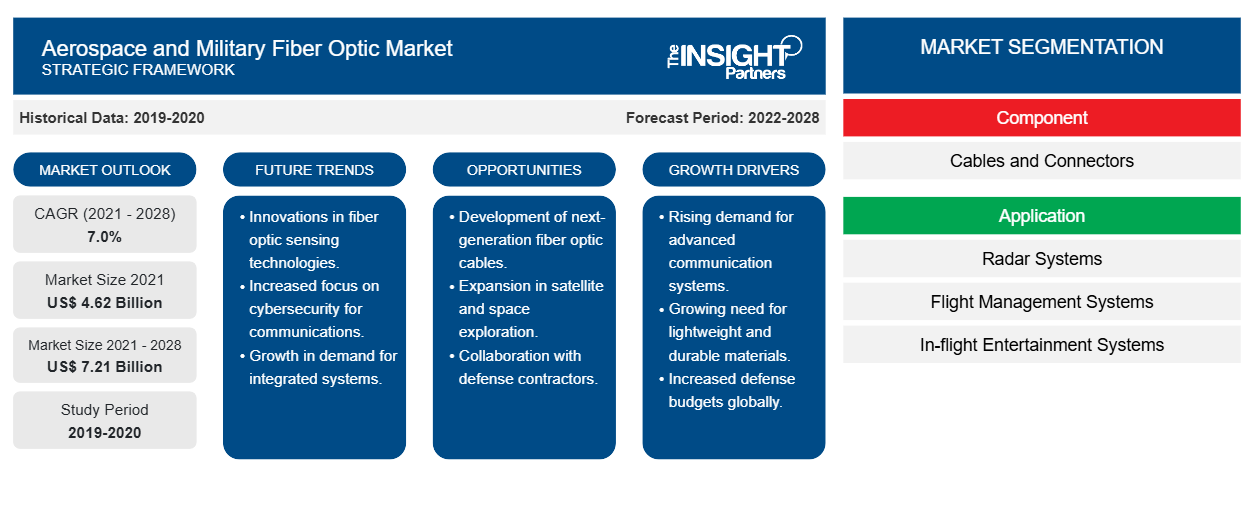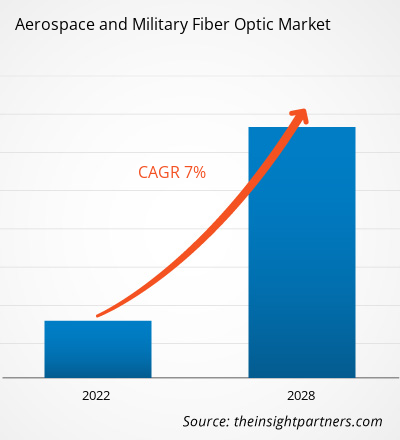The aerospace and military fiber optic market is projected to reach US$ 7,208.36 million by 2028 from US$ 4,623.81 million in 2021; it is expected to grow at a CAGR of 7.0% from 2022 to 2028.
A fiber optic cable is a bundle of optical threads with a diameter (single thread) larger than the diameter of a human hair strand; each of these threads may transfer data encoded as light waves. Fiber optics are replacing metal optics in aerospace and military applications due to their ability to withstand severe environments. The use of fiber optic in data transmission enables the transmission over a long distance, confers immunity to electromagnetic interference, and supports high bandwidth with high rates of speed and no data loss. Fiber-optic cables are lighter and smaller than metal cables and safer for vulnerable activities. The demand for fiber optics in aerospace and military communications is increasing due to efficient flight management systems, communication systems, in-flight entertainment systems, electronic warfare avionics, cabin interiors, and radar systems. The increasing demand for higher bandwidth, reliability, and airframes in new and upgraded aircraft boosts the aerospace and military fiber optic market growth.
According to a recent study from the International Civil Aviation Organization (ICAO), it is expected that passenger and freight traffic is likely to double by 2035. The number of air travelers is increasing with the rising middle-class disposable income and elevated operations and popularity of low-cost airlines. As the number of passengers grows in major countries such as Canada, the US, Brazil, Indonesia, the Philippines, China, Saudi Arabia, and India, the number of commercial aircraft deliveries also spikes. A rise in commercial aircraft deliveries with advanced integrated solutions adds to the demand for fiber optics. According to the Bureau of Transportation, the US airlines reported a significant rise in passenger count from October 2020. A consequent rise in the shift toward the edge of communication, radar, and navigation systems to ensure streamlined airline operations further boosts the growth of the aerospace and military fiber optic market.
Customize This Report To Suit Your Requirement
You will get customization on any report - free of charge - including parts of this report, or country-level analysis, Excel Data pack, as well as avail great offers and discounts for start-ups & universities
Aerospace and Military Fiber Optic Market: Strategic Insights

-
Get Top Key Market Trends of this report.This FREE sample will include data analysis, ranging from market trends to estimates and forecasts.
Impact of COVID-19 Pandemic on Aerospace and Military Fiber Optic Market Size
The COVID-19 pandemic substantially hampered industries in Europe. The COVID-19 pandemic triggered unprecedented policy responses across European countries that hit the region’s economic growth during the Q2 and Q3 of the outbreak. This further resulted in disruptions in multiple supply chains across various European industries due to lockdowns imposed by the European Union (EU) members to curb the outbreak.
The European military was hit hard by the high number of COVID-19 cases in the region from 2020 to 2021. The COVID-19 pandemic also triggered a drop in the demand for military equipment, resulting in reduced production, and negatively impacted European military infrastructure growth. However, in contrast to the factors mentioned above, the European aerospace and military fiber optic market players managed to acquire aerospace and fiber optics contracts from various military forces worldwide. This enabled the market players to generate revenues and contribute to the market growth. Thus, the revenue generated in 2020 was comparatively less than in 2019.
Market Insights – Aerospace and Military Fiber Optic Market
The increasing demand for new and reliable fiber optic cables and connectors for communication systems is also one of the major factors driving the aerospace and military fiber optic market in this region. According to Airbus Global Market Forecast, the commercial aircraft fleet stood at 22,950 units aircraft at the start of 2020, and it is expected to rise to 46,720 units by 2040. The manufacturers of commercial and general aviation aircraft are focused on technologically advanced solutions, such as advanced in-flight entertainment (IFE) and cabin interiors, robust avionics, and enhanced radar systems. The integration of such components with modern fleets is a prime factor catalyzing the procurement of fiber optics, such as cables and connectors. Further, upgrading existing commercial and general aviation aircraft fleets plays a crucial role in driving the growth of the aerospace and military fiber optic market. Continuously flourishing customer-centric business models among commercial and general aviation aircraft owners are substantially boosting the IFE domain, which is propelling the installation of fiber optic cables and connectors, thereby, catalyzing the aerospace and military fiber optic market growth.
Application-Based Insights
The aerospace and military fiber optic market, based on application, is segmented into radar systems, flight management systems, in-flight entertainment systems, communication systems, electronic warfare, cabin interiors, and avionics. The communication systems segment is expected to register the highest CAGR during the forecast period. Communication systems require a high degree of tactical equipment to connect to the global information grid of shared data and information. Fiber optic cable networks are used to send intelligence, surveillance, and reconnaissance data through various communication systems. Satellites, interconnected ground links, and communication systems are important components of communication networks because they allow data to be transmitted securely across secure data links. These data lines use compatible communication protocols to communicate information between allies safely. Thus, all these factors collectively contribute to the growth of communication systems in the aerospace and military fiber optic market.
The aerospace and military fiber optic market analysis is segmented based on component, application, end-user, and geography. Based on component, the aerospace and military fiber optic market size is segmented into cables and connectors. Based on application, the aerospace and military fiber optic market is segmented into radar systems, flight management systems, in-flight entertainment systems, communication systems, electronic warfare, cabin interiors, and avionics. Based on end-user, the market is bifurcated into commercial and military. Based on geography, the aerospace and military fiber optic market is primarily segregated into North America, Europe, Asia Pacific (APAC), the Middle East & Africa (MEA), and South and Central America. Carlisle Interconnect Technologies (US), TE Connectivity (US/Switzerland), AFL (US), W. L. Gore and Associates, Inc. (US), Amphenol FSI (US), Prysmian Group (Italy), Raytheon Technologies Corporation (US), Prysmian S.p.A. (Italy), Nexans S.A. (France), Radiall (France) and Glenair, Inc. (US) are among the key aerospace and military fiber optic market players.
Aerospace and Military Fiber Optic Market Regional InsightsThe regional trends and factors influencing the Aerospace and Military Fiber Optic Market throughout the forecast period have been thoroughly explained by the analysts at The Insight Partners. This section also discusses Aerospace and Military Fiber Optic Market segments and geography across North America, Europe, Asia Pacific, Middle East and Africa, and South and Central America.
Aerospace and Military Fiber Optic Market Report Scope
| Report Attribute | Details |
|---|---|
| Market size in 2021 | US$ 4.62 Billion |
| Market Size by 2028 | US$ 7.21 Billion |
| Global CAGR (2021 - 2028) | 7.0% |
| Historical Data | 2019-2020 |
| Forecast period | 2022-2028 |
| Segments Covered |
By Component
|
| Regions and Countries Covered |
North America
|
| Market leaders and key company profiles |
|
Aerospace and Military Fiber Optic Market Players Density: Understanding Its Impact on Business Dynamics
The Aerospace and Military Fiber Optic Market is growing rapidly, driven by increasing end-user demand due to factors such as evolving consumer preferences, technological advancements, and greater awareness of the product's benefits. As demand rises, businesses are expanding their offerings, innovating to meet consumer needs, and capitalizing on emerging trends, which further fuels market growth.

- Get the Aerospace and Military Fiber Optic Market top key players overview
Players operating in the aerospace and military fiber optic market are mainly focused on the development of advanced and efficient products.
- In 2021, Amphenol Corporation acquired Halo Technology Limited for approximately US$715 million. Halo is headquartered in Tustin, California, with operations in North America and Europe, and is a leading provider of active and passive fiber optic interconnect components for the communications infrastructure markets, and had sales of approximately US$250 million in 2021.
- In 2021, Amphenol Corporation acquired Positronic to provide customers with a broad range of products and technical design support for their interconnect solutions.
Frequently Asked Questions
What are the reasons behind aerospace and military fiber optics market growth?
What are market opportunities for aerospace and military fiber optics market?
Which region has dominated the aerospace and military fiber optics market in terms of 2021 market share?
Which are the major companies in the aerospace and military fiber optics market?
Which component segment is expected to dominate the market in terms of 2021 market share?
- Historical Analysis (2 Years), Base Year, Forecast (7 Years) with CAGR
- PEST and SWOT Analysis
- Market Size Value / Volume - Global, Regional, Country
- Industry and Competitive Landscape
- Excel Dataset
Recent Reports
Related Reports
Testimonials
Reason to Buy
- Informed Decision-Making
- Understanding Market Dynamics
- Competitive Analysis
- Identifying Emerging Markets
- Customer Insights
- Market Forecasts
- Risk Mitigation
- Boosting Operational Efficiency
- Strategic Planning
- Investment Justification
- Tracking Industry Innovations
- Aligning with Regulatory Trends





















 Get Free Sample For
Get Free Sample For